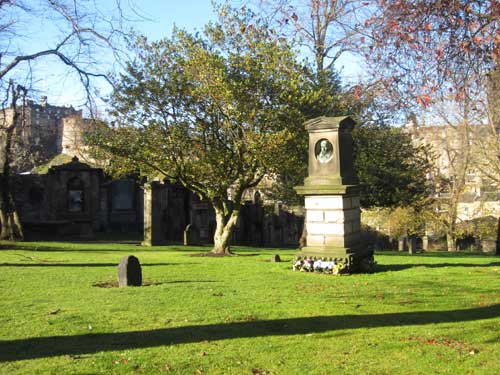The 2 1/2 hour walking tour offered by Sandeman's started at 11 am. The group was so large that they split us into several smaller (but still large) groups... and still ended up turning people away (so it was good that I arrived a bit early). Paula was our guide.
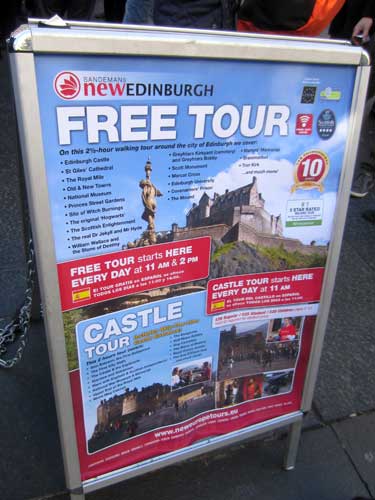
We walked up the street a block to our first stop, the city chambers, built in 1753 - 1761. While it only looks like the building has 4 stories, it actually has 12! We just can't see the other stories from this side because it's built over the side of the cliff.
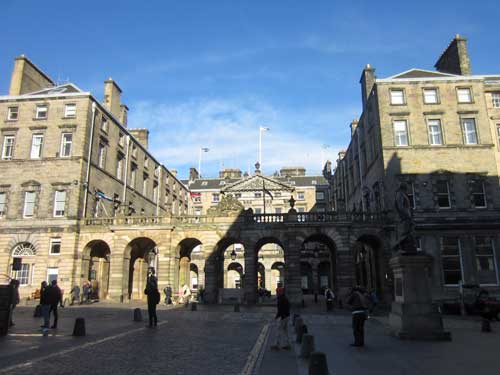
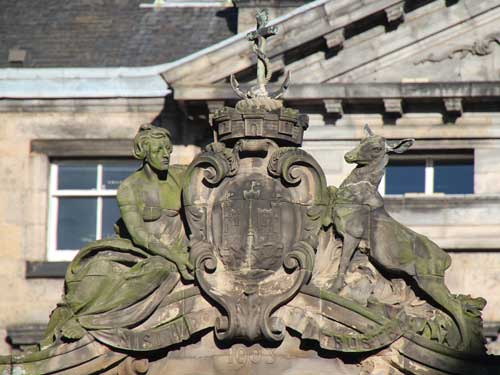
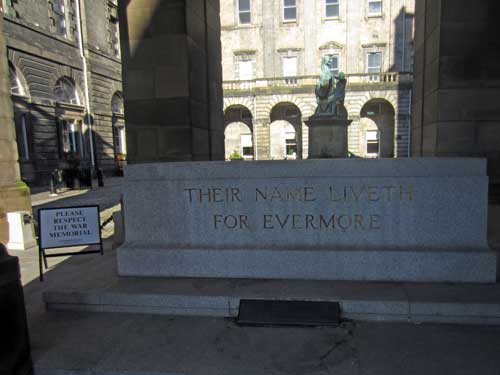
At the entrance is the Great War Stone, commemorates residents who died in World War I.
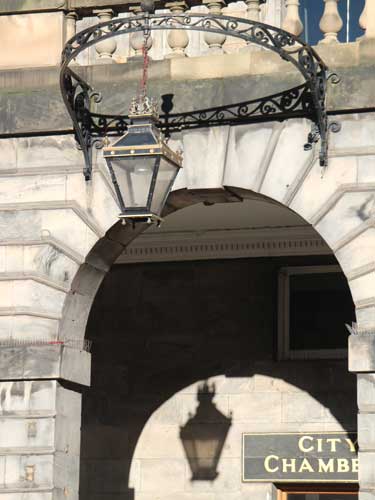

Inside the courtyard
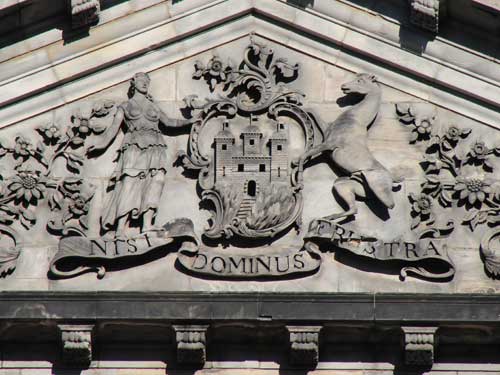
Hmmm... I'm detecting a theme.
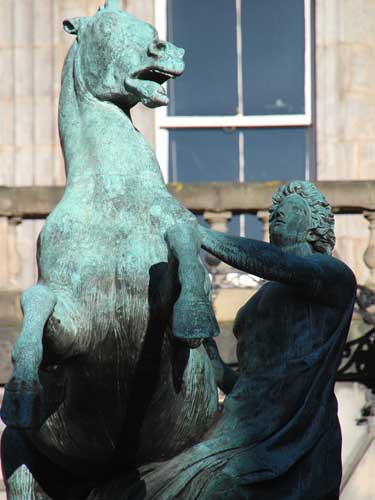
The statue of Alexander Taming Bucephalus, by John Steell, was modelled in 1832 but not cast in bronze until 1883. It was moved here in 1916.
We popped across the street to Parliament Square. It was nice having walked past a lot of this stuff already. The big giant pillar was called a mercat cross (or market cross). Despite the name, it wasn't an actual cross ...or at least hasn't been for some while.
This served as the location for several things. First, it was the place for public announcements. In the old days, it took three days to ride from London to Edinburgh to deliver the latest news. The town crier would then stand on the top of this pillar (usually wood at the time) and yell out the information. In honor of tradition, they still do this for royal proclamations. They did this fairly recently when the new prince was born. Of course, everyone had already had long since heard about it from the tv or internet.
The second function was for public displays of punishment. Often the punishments were torture or executions, and a crime such as theft could be considered as bad as murder. But some punishments were survivable. Let's say you were a woman whose husband had died and you were stealing potatoes for your kids to eat.... and unfortunately you got caught. If they took mercy on you, they might hammer you to this pole (remember, it used to be wood) with a thick wooden stake through the ear for 24 hours. Your fellow citizens would come to kick you, empty their bedpans on you, yell insults at you, etc. If you managed to make it through your sentence, they would remove the stake and you could rejoin society. The scar would show people you did your time for your crime and you are 100% forgiven. If you couldn't handle it, however, and pulled away early (either ripping off your ear or otherwise causing damage), then you would never be welcomed back... in any city. Your best option was go sign up with a ship and become a pirate (or in the case a woman... a prostitute on a ship). Either way, you probably died an early death... either captured and hung as a criminal or of syphilis.
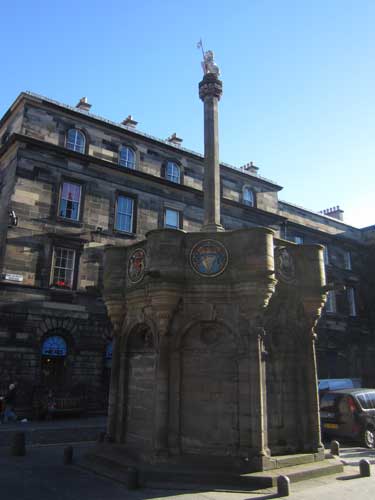
This is an 1885 replacement of the original cross removed in 1756.
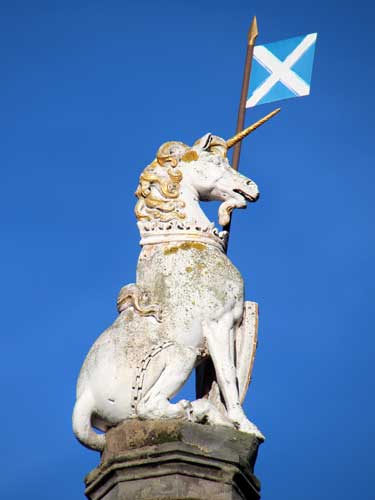
Perhaps instead of a unicorn there did indeed used to once stand a cross.
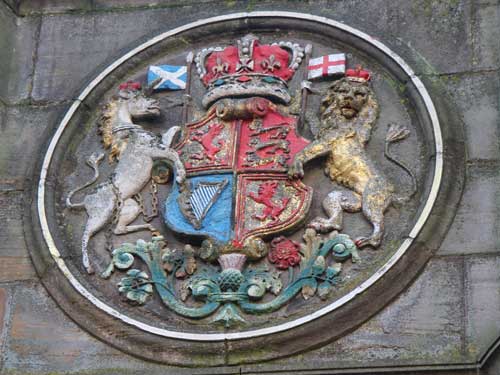
Sometimes, one of the unicorns is a lion. This was done in a gesture of unity, symbolizing the union between Scotland and England. These two animals, once mortal enemies, were now shown under the same crown... the unicorn with its harmony and the lion with its might.
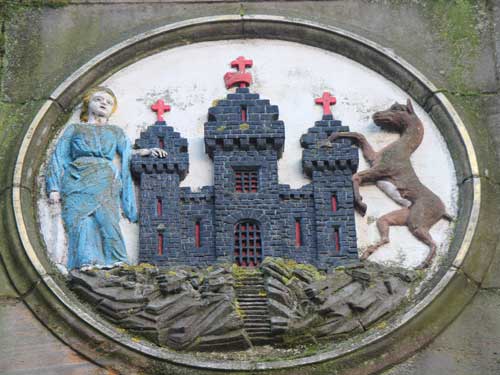
This is apparently the city's Coat of Arms (which explains why we had already seen it twice at the city chambers). This is based on one from 1732.
As we stood in the shadow of St. Giles' Cathedral, we were told some stories. Supposedly a church needs to have a bishop in order to officially be called a cathedral... but this one doesn't. Apparently that's one of the many differences between the Church of England and the Church of Scotland. England also prays to God and king, whereas Scotland leaves the king part off.
In 1707, the two countries were merged as a single United Kingdom of Great Britain. For the most part, they tolerated each other and the churches kept doing their own thing.... until one Sunday in 1637 the prayer books were changed. The Scottish didn't like this at all! It is said that one woman, Jenny Geddes (1600 - 1660), stood up and threw her stool at the minister. Everyone promptly followed suit and a large riot ensued. The protests spread to the streets and even to other cities, including talk of civil war.
Eventually the protesters wrote the National Covenant, swearing an oath to their religion in the form that it existed in 1580 and to reject all religious reforms. They signed it in the local Greyfriars Kirkyard in 1638. In November of that year, the bishops were formally expelled from the Church of Scotland... and war began... actually, many wars began. The "Covenanters" remained in control of Scotland for the next decade. Eventually they were defeated in 1650-2 by English forces under the command of Oliver Cromwell.
In 1662, the retaliation began. Large numbers of Covenanters were jailed, tortured and executed for treason. The bishops returned (in spite of being assassination target)s. The Covenanters made several rebellion attempts, most which ended in disaster. Unfortunately this persecution only served to intensify their beliefs. Violence begot more violence, and the government responded by authorizing field executions without trial. Often the corpse was hanged or beheaded first, and burying the body in the kirkyard could result in another punitive death. If they had been given a decent burial, their bodies were usually disinterred and buried in places reserved for thieves.
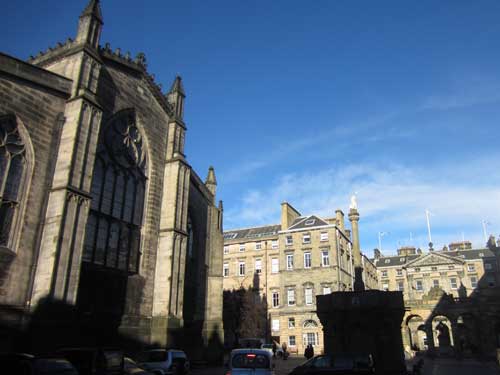
On a happier note, Sean Connery was knighted here. Also, there is supposedly a statue inside of an angel with bagpipes.
We turned down an alleyway called a 'close', which is short for enclosure, that led to a courtyard. There were many many of these small courtyards that lined the main street, hidden from view by these tiny passageways. We ended up at Lady Stair's Close. Some of these courtyards were named after someone famous or something that happened... or in this case, simply the richest person who lived there.
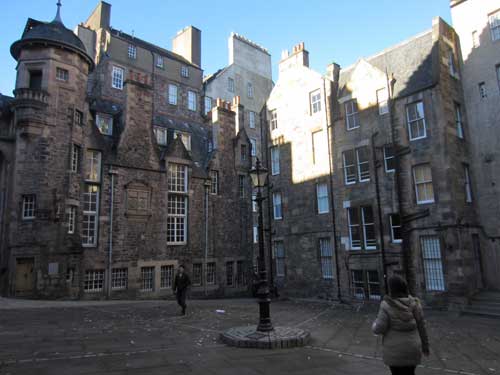
The buildings were always built as tall as possible (to crowd as many people into the city as they could). Some buildings got up to 12 stories high, although the last 2 or 3 floors were only made of wood. Unlike today, the most expensive apartments were on the ground floor and not the top, since if there was a fire, you wanted to be able to escape.
There were no traditional bathrooms back then. People went in a chamber pot and then tossed the contents out the window into the street. As they emptied the pot they would call out "Gardy-loo" (originally from the French "“Garde a l’eau!” or “Watch out for the water!”... this eventually got shortened to just "loo" which is what the British call a toilet today.)
As you can imagine, this got to be QUITE messy. So they made a law called The Nastiness Act. Yes, indeed. Anyway, the law stated that chamber pots could only be emptied at 7 am and 10:30 pm daily. It just so happened that 10:30 pm was the closing time for the bars. So picture a scene of some guy stumbling home in a drunken stupor. He hears someone call from above and he looks up... yeah, exactly. This is supposedly where the phrase "getting shit-faced drunk" originates from. Not pretty.
In spite of creating a more orderly way to toss stuff out the window, stuff was still just getting tossed out the window... and the smell was horrendous! This is what was being washed by the rain into Nor Loch, causing it to be so incredibly polluted. Not only that, but methane would build up. This caused random explosions as well as hallucinations! It's no wonder they drained the thing in the mid-1700's and built New Town.
Lady Stair's old residence was turned into the Writers' Museum.
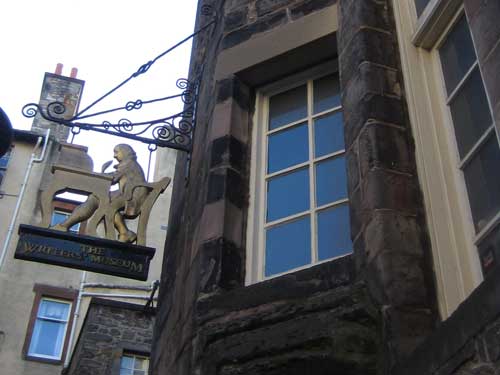
There have been many famous written works that have come from this ear. JK Rawlings (who wrote the Harry Potter series) was from England but lived here after her divorce. She spent much time writing in a small cafe and used the surrounding landmarks (such as the school or names from gravestones) in her books.
Scottish author Robert Louis Stevenson wrote the Strange Case of Dr Jekyll and Mr Hyde that was first published in 1886, based on a local man named Deacon Brodie.
Robert Burns (aka Scotland's favorite son) wrote "Auld Lang Syne" (meaning roughly "long, long ago" or "for the sake of old times"... something like that) here in 1788. This is the song that is traditionally sung at the stroke of midnight on New Year's... although most people simply mumble the words because a) they've had too much to drink or b) not many people really know them in the first place!
Here's the first verse (as we sing it our English-ified version):
The poem is, of course, a lot longer than that... but most people want to rush right into the celebration of kissing the person they are with.

Leaving the close
We made our way to the side of the castle (where I had been earlier) and got to hear more stories.
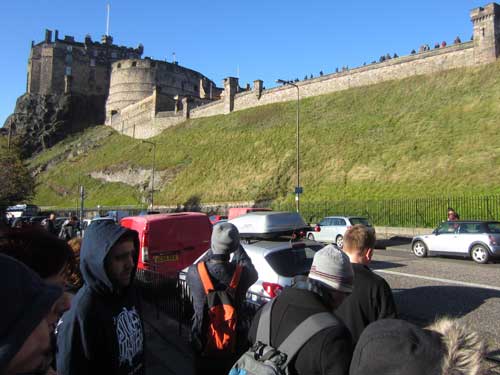
Edinburgh became the capital in 1492, having moved from Stirling. Basically, the capital used to be wherever the king was. The first castle on this chunk of old volcanic rock was built around 3,000 years ago. It offered good views of the water and approaching ships.
We then learned about the "Four Honours of Scotland" which are a crown, a sword, a scepter... and the Stone of Scone (or the Stone of Destiny). This was apparently a large lump of sandstone weighing about 335 pounds. It wasn't even nicely carved. But a prophecy said that wherever the stone lies, the Scots shall rule. It was basically the Coronation Stone of the original Scottish kings.
In 1296, the Stone was captured by the the king of England (Edward I) as the spoils of war and taken to Westminster Abbey where it was placed under the throne and sat for 700 years. In 1320, the Scottish petitioned the Pope to have the English give their stuff back. They got the crown, sword and scepter but not the stone.
In 1950, a group of four Scottish college students actually managed to steal the stone and smuggle it back to Scotland. Unfortunately because it was so heavy, they dropped it in their panic of trying to get out of the Abbey and it broke into two pieces. They could carry the small piece but had to drag the large piece to the car by puling it on a jacket. The English, upon noticing its theft, immediately closed the borders. So the students buried the stone in a wet field. Eventually, with the assistance of a band of Irish gypsies (who also weren't too fond of the English), they managed to smuggle the stone into Scotland. They had it repaired in Glasgow, then it was stored in a church. But eventually word leaked out and it was hauled back to London.
Then in 1996, in a gesture of good will during some political unrest, the British government decided that the stone should be kept in Scotland when not in use at coronations. It arrived at Edinburgh Castle on 30 November 1996 and was treated as a visiting head of state. It was paraded up the Royal Mile with Buckingham Palace guards at its side. Jets flew overhead.... and they even had the theme song from Mission Impossible playing in the background! It currently rests with the other Honours (or crown jewels) of Scotland.
In 1999, Scotland was granted its own parliament. The joke is now, that with plate tectonics and the land masses still shifting, that someday Scotland will finally truly break free from England as the plates pull apart.
Our next stop was the grass market where the farmers would come to sell their crops. Eventually it was changed to a public execution site because the area was so large that it could accommodate the thousands of people who would come to watch. The last hanging was in 1864 after which point the officials realized it actually wasn't all that good at deterring crime. It had turned into a sort of entertainment. Eventually this turned into a bad area, filled with bars, brothels, and a very rowdy crowd. Nowadays it is filled with cafes and restaurants. And on that note, we took 10 minute break to get out of the bitter cold and warm up a bit.
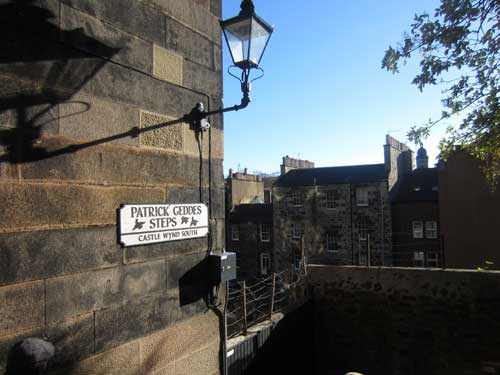
Heading to the next section of town

Paula, our guide, sharing many wonderful stories in the grass market
After we had thawed a bit in a charming little place appropriately called The Last Drop, we headed over to the location of the gallows.
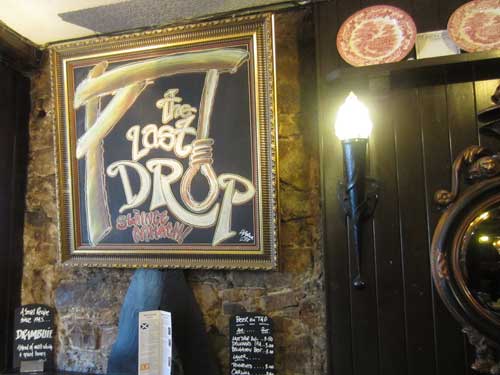
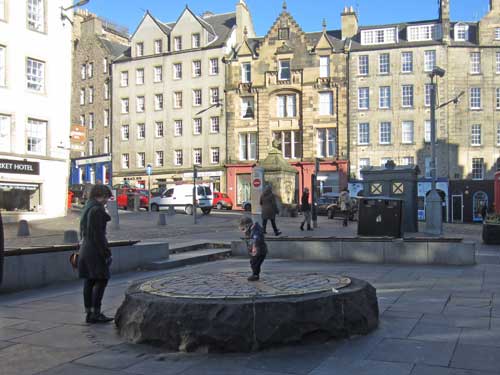
The site of the old gallows. The young child most likely has no idea what he's playing on!
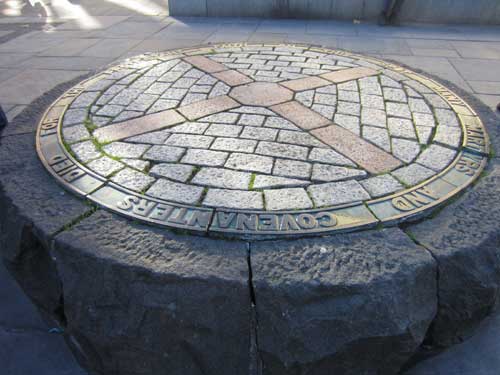
A hundred Covenanters were killed here.
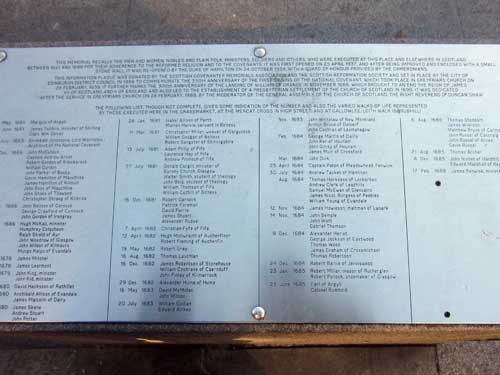
A long list (by no means complete) of those executed here and elsewhere in Scotland between 1661 - 1688... lots of ministers, a couple students of theology, a shoemaker, a weaver, a mason, a 'maltman', an earl, a servant, a couple captains, etc
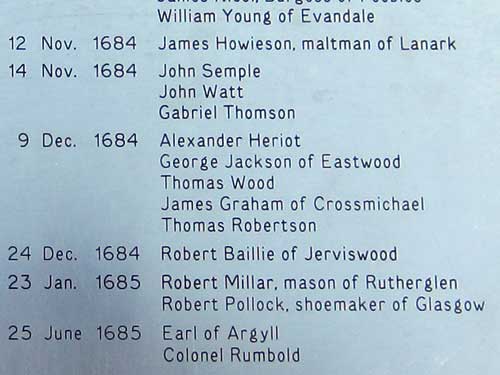
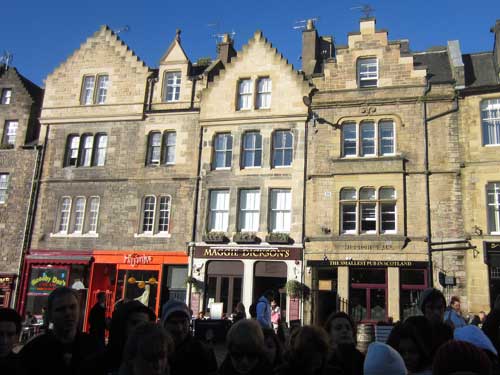
Listening to the stories
In 1723, Maggie Dickson's husband had left her so she moved to a small town in order to find work. She got a job at an inn but ended up having an affair with the innkeeper's son. Being in the days before birth control, she naturally got pregnant but kept it a secret. The baby was born 2 months premature and died. She brought it to the river to dispose of it, but instead of sending it away, she decided to honor it with a burial. Eventually the little body was found and was traced back to her. She was promptly arrested... but no for any reasons you might think.
The Concealment of Pregnancy Act had been written up to try to prevent people from killed their children when they were born because they couldn't afford to feed them. " - if any woman shall conceal her being with child during the whole space and shall not call for and make use of help and assistance in the birth, the child being found dead or amissing, the mother shall be holden and reputed the murtherer of her own child -" Later, the punishment was made less severe, but at that time, the punishment was death. And so, on September 2, 1724, Maggie was hung on the gallows and pronounced dead.
After hanging the customary 30 minutes, her body was cut down and carted away in a coffin to a cemetery several miles away. Somehow during the trip, she revived and started scratching and clawing at the wooden box encasing her. The terrified driver opened the box, and upon discovering she was still alive, promptly brought her back to the gallows to be hung again.
Once again she found herself with a noose around her neck, standing on a chair about to be kicked out from under her. Suddenly a law student in the crowd spoke up and said she should be set free. She had done her sentence, had been pronounced dead, so let her go. And they did!
Now, not only was she alive, but she was also free from her husband ('til death do you part) and could start over. She lived another 25 years.
We headed over to the Greyfriars Kirkyard which was filled with even more gruesome stories.

Some views of the city
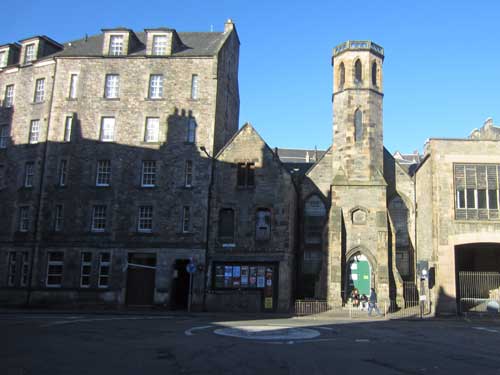
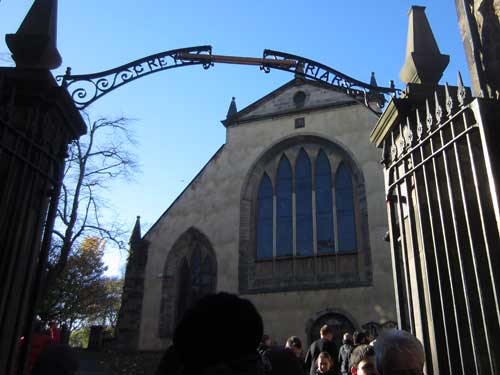
Entering Greyfriars Kirkyard
The lovely green field contained 435 tombstones, but thousands are actually buried here. It is jokingly called the "Edinburgh lasagna." Since there was not enough room for everyone, they began to bury on top of each other in layers.... squeeeeezing new grave between old ones, pushing others aside, etc.
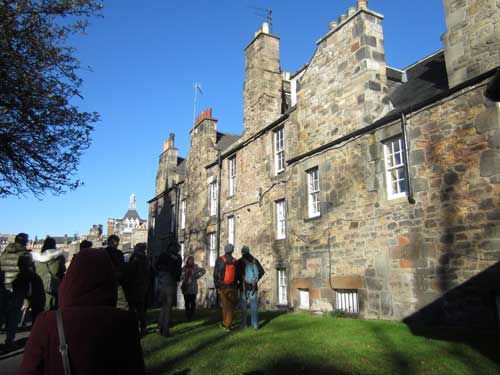
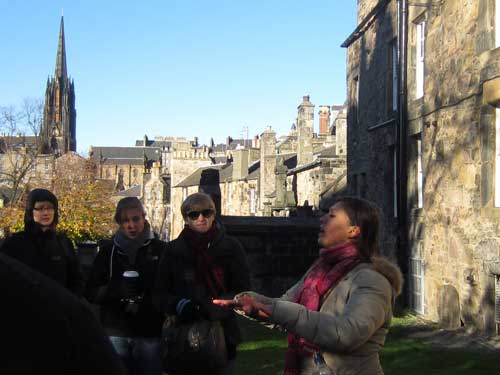
Great stories in a great setting!

Apparently there are a LOT more bodies here than meets the eye!
